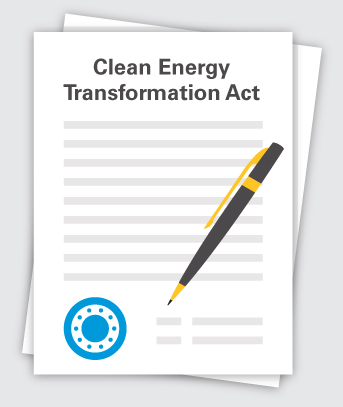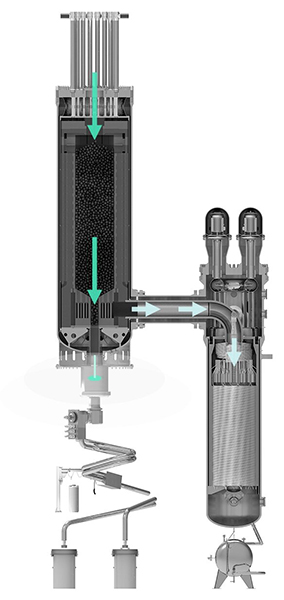Nuclear Power
Planning for the future
Grant PUD is in the early stages of exploring another source of electricity for our growing county that is as reliable as hydropower and as clean. Learn more here about our efforts and what’s driving them.
Why is Grant PUD exploring nuclear power?
Why is Grant PUD exploring nuclear power?
Our county’s growing need for energy, coupled with the carbon-free fuel targets recently signed into Washington state law, have made it clear we will need new, carbon-free generation capacity installed within the next decade. We have determined that nuclear energy produced by scalable, "small modular reactors" is an option to consider. We are evaluating a power plant designed by X-energy, which initial analysis found to have tremendous potential. To learn more about the X-energy reactor click here.
We're Growing
Grant PUD’s Integrated Resource Plan shows our county’s demand for electricity outgrowing the generation and financial benefits of our dams by approximately 2026, especially at times of peak demand.
We’ll fill the gap with power purchased from the regional wholesale market in the interim. Longer term, we may choose to build and operate a new generating resource capable of producing “baseload” —reliable power that, unlike weather-dependent wind and solar power generation, is always there when our customers need it.
Load growth: A look ahead
Clean Energy Transformation Act (CETA)
Washington has set timelines to eliminate carbon from its electricity base by 2045. Utilities that don’t comply face penalties that will add to operation costs and contribute to rate increases for our customers.

About X-energy's small modular reactors (SMRs)
Electricity generated by small modular nuclear reactors is highly regulated, carbon-free and a reliable source of baseload power. We are exploring the feasibility of building and operating our own X-energy small modular nuclear power plant at a site still to be determined sometime in the 2030s.
X-energy technology
X-energy’s nuclear reactor designs are based on HTGR technology — a Generation-IV reactor technology with a proven operational pedigree.
Xe-100
- 220,000 Graphite Pebbles with TRISO Particle fuel
- High temperature tolerant graphite core structure
- ASME compliant reactor vessel, core barrel & steam generator
- Designed for a 60-year operational life
- Flexible application – electricity and/or process heat
- Base load or load following
- Online refueling (95% plant availability)
- High burn-up fuel cycle (160 GWd/tHM)

Frequently Asked Questions
Click here to read more about why we're considering nuclear power.
No location has been determined. Project site location will be decided by Grant County PUD with input from a variety of stakeholders.
Definitely Billions with a B. A key part of our evaluation process is determining total project cost and key timeline milestones.
Grant PUD is exploring this nuclear power option as a way to keep rates low in the future, while meeting our customers’ growing power demands. Customers in our core group – residential, irrigation and small business – have price protections based on board policy. This policy ensures that core customers will be first in line to receive the pricing benefit of generation at our dams, while larger load customers would pay for additional power generation costs to meet their needs beyond what is produced at our dams.
Existing nuclear energy facilities are already extremely safe and the industry continuously evaluates and implements new procedures, systems and technologies to address any potential event. Through innovative designs and fuels, advanced nuclear energy technologies take safety to another level. The Xe-100 reactor utilizes TRISO fuel, which cannot overheat, making this reactor walk-away safe (meaning the plant atomically shuts down without any human action). The inherent safety of the fuel, combined with other safety features – such as the use of helium instead of water – makes this the safest nuclear energy design to date.
This is a very difficult question to definitively answer. It depends on the type of reactor, where we put it, political will, social will, funding, and several other factors. We know as a district we are looking at a need for new generation becoming reality somewhere in the 2030 range. That's why we're exploring small modular reactor technology as a potential solution in the next decade.
Grant PUD is evaluating X-Energy's technology.
It is Grant PUD’s intention to have an ownership stake in the proposed plant. With multiple promising structures, and time for continued evaluation, the partners will work together to identify the best fit for the project and the region’s future clean energy needs.
We are exploring nuclear power as a resource that would be owned and operated by Grant PUD. That would mean Grant PUD would need to hire employees to operate and support such a plant.
Yes. Estimates are between 100 and 300 full-time employees for plant operations and maintenance. However, total employment figures will depend on the size and scope of the project.
Compared to the existing fleet of nuclear energy reactors, advanced and small modular reactors will be easier, faster and more affordable to build since they can be manufactured off-site and then be assembled at the project location. These savings, combined with lower operating costs – resulting from a smaller footprint, design improvements and safety enhancements – provide significant cost reductions.
Theoretically, nuclear energy could replace all of the output from carbon-emitting resources that are retired. From a technical standpoint, replacing these plants with advanced reactors is not only possible, but would provide additional benefits (reliability, dispatchability, and economic benefits such as jobs, economic activity, construction, and development). However, the most practical, feasible, and achievable option is a combination of new advanced nuclear generation and renewables.
The nameplate capacity for Priest and Wanapum are 950MWe and 1200MWe, respectively. The standard X-energy design is a four-pack 320 MWe power plant. However the design is scalable in 80 MWe increments, allowing additional generation capacity to be added to meet increased demand.
